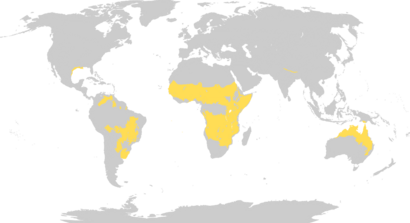Tropical and subtropical grasslands, savannas, and shrublands facts for kids
Imagine huge areas of land covered mostly by grass, with some scattered trees or bushes. These places are called tropical and subtropical grasslands, savannas, and shrublands. They are special types of biomes, which are like big natural neighborhoods where certain plants and animals live. You'll find them in warm parts of the world, closer to the Equator, where it's not too wet and not too dry.
These biomes are usually found between 5 and 20 degrees north and south of the Equator. They are defined by the World Wide Fund for Nature as important natural areas.
Contents
What are these amazing places?
These biomes have different names depending on what plants grow there:
- Grasslands are mostly covered by grasses and other small, soft plants.
- Savannas are grasslands that also have scattered trees. Think of the African plains with acacia trees!
- Shrublands are areas where you mostly see woody or bushy plants, called shrubs.
These tropical areas don't get enough rain to have thick forests. Instead, they get about 90 to 150 centimeters (35 to 60 inches) of rain each year. Sometimes, almost all the rain for the whole year falls in just a few weeks!
Plants and trees
Many famous savannas are in Africa. Here, you'll find special trees like acacia and baobab trees. Acacia trees drop their leaves during the dry season to save water. Baobab trees are amazing because they store water in their huge trunks, helping them survive the dry times.
Animals of the grasslands
These habitats are home to many large animals that eat the abundant grass and plants. The richest animal life is found in the savannas and grasslands of Africa.
You can still see huge groups of animals migrating, like wildebeest (a type of antelope) and zebra. They move across the land looking for fresh food and water. Sadly, these amazing migrations are becoming smaller because their homes are changing and due to hunting. Today, you mostly see them in East Africa and parts of central Africa.
The climate of these regions
The weather in these areas, sometimes called the "Sudan type of climate," has two main seasons. There's a hot and rainy season, and then a cool and dry season. In the northern half of the world, the rainy season usually starts in May and lasts until September. The amount of rain can change a lot, from 25 to 150 centimeters (10 to 60 inches), and it's not always reliable. The rest of the year is cool and dry. As you move further away from the Equator, the rainfall usually decreases. It's also very common for these areas to experience droughts.
Where can you find them?
You can find tropical and subtropical grasslands, savannas, and shrublands on every continent except Antarctica. They are very common in Africa. You'll also see them across South Asia and Southeast Asia, in the northern parts of South America and Australia, and in the southern United States.
See also
- Tropical vegetation


